词汇学第三章
- 格式:doc
- 大小:36.00 KB
- 文档页数:3

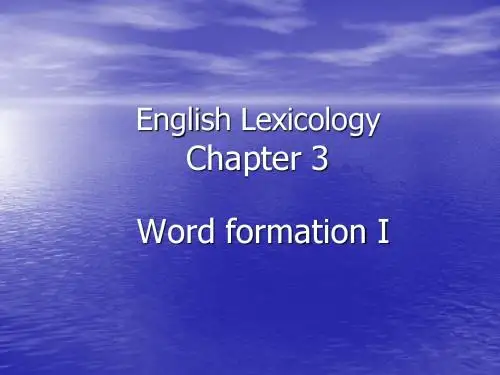
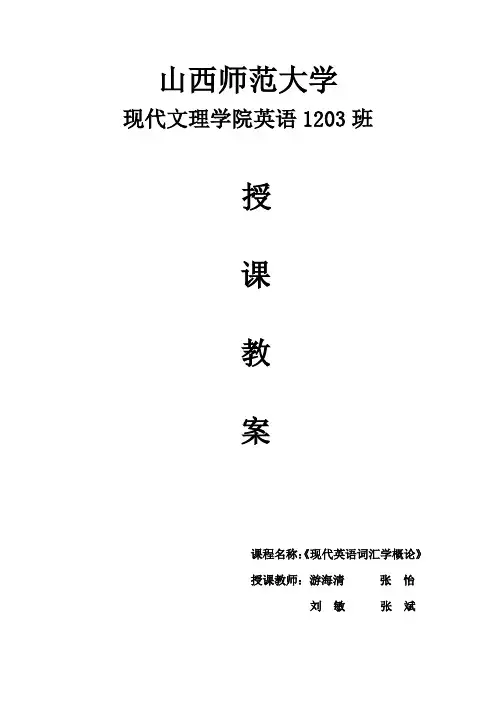
山西师范大学现代文理学院英语1203班授课教案课程名称:《现代英语词汇学概论》授课教师:游海清张怡刘敏张斌构词法教案课题: WORD-FORMATION(I)授课教师:游海清教材:现代英语词汇学概论第 3 章第 1-4 节P 31 ~P 71一、教学目标:1、知识目标:a.了解构词法的一些基本知识和观点b.明确合成法的定义c.掌握合成法的分类d.了解派生法及转化法的定义e.熟练掌握派生法及转化法的分类f.明确常见前后缀的词义2、能力目标:a.提升学生记忆单词的能力b.理解构成的新词的意义c.扩大词汇量,提升阅读水平二、教学重点:合成法派生法转化法三、教学难点:转化法四、教学方法:讲授法问答法 PPT演示练习法课堂讨论法对比法五、教具仪器:多媒体粉笔教案教材六、授课提纲:七、教学内容详析第一节General remarks 第一步:T:OK,class,let’s begin.How many processes of word-formation do you know ?Do you know differences between root,stem and base?第二步:A.percentage of new wordspounding or composition(about 27%)B.Derivation or affixation(about 17.5%)C.Conversion(about 10.5%)A.initialisms and acronyms(about 9%)B.Blending(about 6%)C.Clipping(about 2%)D.Words from proper names(about 2%)E.Back formation(about 1%)F.Reduplication(about 0.5%)G.Neo-classical formations(about 4%)H.Others (about 3%)B.Some basic concepts of word-formation1.The differences between “root”, “stem” and “base”?Root/ 词根: is not further analyzable, either in terms of derivational or inflectional morphologyStem/ 词干: the part of the word-form which remains when all inflectional affixes have been removed.Base/ 词基: any form to which affixes of any kind can be added.举例:1)undesirables= un + desire + able + sBase:desirable→ desire (base)undesirable→ desirable (base)undesirables→ undesirable (base)Base/词基: any form to which affixes of any kind can be added.分析:desirable: desire(root or base, not stem)undesirable: desirable(base, not root, not stem)undesirables: undesirable(stem or base, not root)desired: desire(root, stem or base)第三步:1)denationalizeddenationalized = de + nation + al + ize + dRoot:nationStem:denationalizeBase:national→ nationnationalize→ nationaldenationalize→ nationalizedenationalized→ denationalize2)Uncomfortable=un +comfort+ableRoot: comfortStem:uncomfortableBase:comfortable第二节:Compounding第一步:板书下列单词1.noun compoundsHeadache heartbeat crybabyPickpocket birthcontrol housekeeping2.adjective compoundsThunder-struck weather-beaten suntannedFault-finding peaceloving record-breaking3.verb compoundsHouse-keep ghost-write aircondition mass-produce第二步:A.DefinitionCompounding / composition: a word-formation process consisting of joining two or more bases to form a new unit.e.g.flowerpot= flower + potmachine-independent= machine + independentThe relative criteria of a compound 1) Orthographic criterion:Compounds are written in three ways, that is, solid,hyphenated and open.E.g. flowerpotSolid: flowerpotHyphenated: flower-pot Open: flower pot2) Phonological criterion:C ompound accent: a main stress on the first element andsecondary stress on the second element.Normal phrase accent: a secondary stress on the firstelement and the main stress on the second element.E.g.black listblackboardblue bottle3) Semantic criterion:Semantically, compounds can be said to have a meaning whichmay be related to but cannot always be inferred from the meaningB.Classification1)noun compoundsA.Subject and verbB.verb and objectC.verb and adverbialD.subject and objectE.restrictive relationF.appositive relation2)adjective compoundsA.subject and verbB.verb and objectC.verb and adverbialD.noun and adjectiveE.coordinating relationship3)verb compoundsA.back-formationB.Conversion第三步:做P66-P67练习第三节 Derivation第一步:T:OK,class,let’s begin.Un-uncomfortable unimportant unclean unable unclear unknown Unlike uncertainIm-impossible impatient impair impracticable impolite imbalance immoral impartial impassive imprisonDis-dislike dismiss disclose disrupt disabuse disadvantage disable discharge display disagreeEr(or)-actor teacher doctor driver writer rider commander worker traveller collector farmer cooker baker stranger foreignerAble-actionable companionable comfortable disable livable reliable accountable reasonable fashionable impressionable Ize-civilize symbolize realize naturalize socialize characterize revolutionize materialize第二步:A.definition:Derivation / affixation: a process of forming new words by the addition of a word element, such as a prefix, suffix or combining form, to an already existing word.e.g.recover= re + coverworker= work + erB.classification(一)Prefixation: adding a prefix or combining form to the base.do not generally alter the word-class of the base.1)classification of prefixes1. negative prefixes (反意前缀): un-, non-, in-(im-, il-, ir-), dis-, a-2. reversative / privative prefixes(相反动作前缀): un-, de-, dis-,3. pejorative prefixes (贬义前缀): mis-, mal-, pseudo-4. prefixes of degree or size(等级与大小前缀): arch-, super-, out-, sub-, over-, under-, hyper-, altra-, mini-5. prefixes of attitude(态度取向前缀): co-, counter-, anti-, pro-6. locative prefixes(方位前缀): super-, sub-, inter-, trans-7. prefixes of time and order(时间顺序前缀): for-, pre-, post-, ex-, re-8. number prefixes(常用数字前缀): uni-/mono-, bi-/di-, tri, multi-/poly-9. miscellaneous prefixes: auto-, neo-, pan-, proto-, semi-, vice- 1.2)brief description of some productive prefixes in current English1. ant- / anti-Anti-Japanese War抗日战争ant- / anti-: unlike tradition2.de-A.to undo or reverse .Eg: decentralize decolonize denationalizeB.to removeEg: defog debug delocalize denuclearize3.mini-A.very smll size,duration,or importanceEg: minibus minibike minicab miniparkB.shortEg: minidress miniskirt minicoat minisuit4.un-A.not,the opposite ofEg: unkind unsee unbendingB.reverse the actionEg: unpack untieC.release from or to deprive ofEg: unleash unhorse(二)Suffixation: suffixation is the formation of a new word by adding a suffix or a combining form to the base, and usually changing the word-class of the base.1)classification of suffixes1.noun suffixes:2.Verb suffixes:3.Adjective suffixes:4.Adverb suffixes:2)brief description of some productive suffixes in current English.1.-able2.-er(or)3.-in4.-ish5.-ize6.-y3)differentiating suffixesEg:-ic and -ical第三步:引导学生口头总结第四节conversion第一步:绕口令1.never trouble trouble till trouble troubles you2.Can you can a can as a canner can can a can 你能像罐头工人那样把罐头装进罐头盒子里吗?3.I wish to wish the wish you wish to wish,but if you wish the wish the witch wishes,i won’t Wish the wish you wish to wish 我愿许你所许,若你的愿望太过虚幻不切实际,我就不会许你所许(我就不会和你一起天真的去幻想了第二步:A.introductory remarks1 )Conversion is a word-formation process whereby a word ofa certain word-class is shifted into a word of another word-class without the addition of an affix.functional shift:concerned with usage only not with word-formation derivation by zero suffix:long and cumbersome; clarify only something minor, not crucial2)conversion as a result of the almost entire loss of inflection in modern English.B.tapes of conversion1.noun→verb conversion(a) to put in/on N.The workers canned apples.put apples in cansThis room was floored with titles.cage birdsThe question certainly cornered me.He pocketed his wallet.(b) to give / provide N.They sheltered the orphans.give shelter to the orphanspills coated with sugarsugared pillsThe bottle is labeled poison.The child rose from the ground plastered over with yellow clay.(c) to remove N.Bill weeded the garden.cut off weeds in the gardencore an applepeel an orangedust a cap(d) to do sth. with N.John braked the car.stopped the car with a brakescrew the two pieces togetherelbow one’s way through the crowd(e) to act as N.She mothered the orphan. (human n.)looked after the orphan like a motherTom parroted what the boss had said. (animal n.)repeat sth. like a parrotThe police shadowed the suspected spy. ( inanimate n.) follow the spy closely like a shadow(f) to make / change sth. into N.(g) to send sth. / go by N.(h)to spend the period of time denoted by N.2.verb→noun conversion(a) He had a desire to be a scientist.desired to be a…state of mind / sensation(b) His usual morning commute to workan act of commuting event /activitydynamic verbsThis kind of nouns usually occur following verbs like give, have, make, or take, and are preceded by the indefinite article.(c) This little restaurant is quite a find.sth. found, esp. sth. valuable or pleasingobject or result of v.(d) He is a great bore.He is a person who bores everyone.agent of v.(e) The cloth is a good cover for the table.I covered the table with a cloth.instrument of v.3.adjective→verb conversion(a) pale, slim, sourto become the adj.(b) free, warm, smoothto cause sb. / sth. to become the adj.4.adjective→noun conversion(a) Partial conversionthe poorthe Scotch / the Japanesethe roughthe latest / his bestthe accused(b) Complete conversionHe is a natural for the job.Tom is one of our regulars.5.Other conversions第三步:布置作业八、预期效果学生能熟练运用合成法、派生法、转化法以及掌握由三大构词法构成的新词的意义。

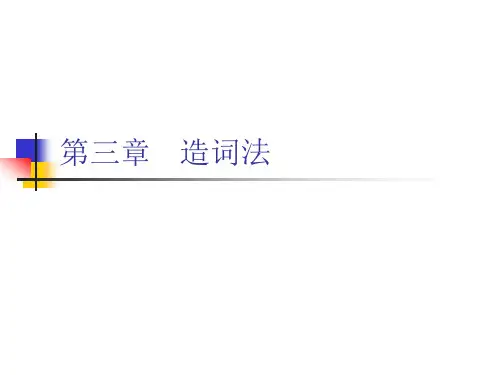
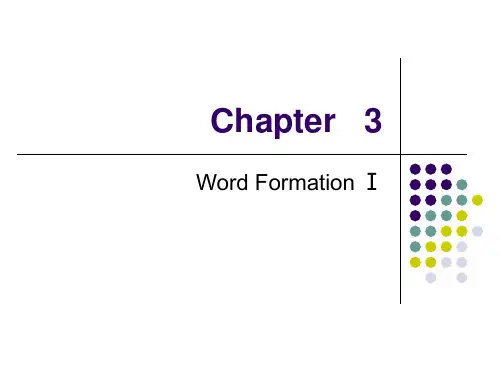
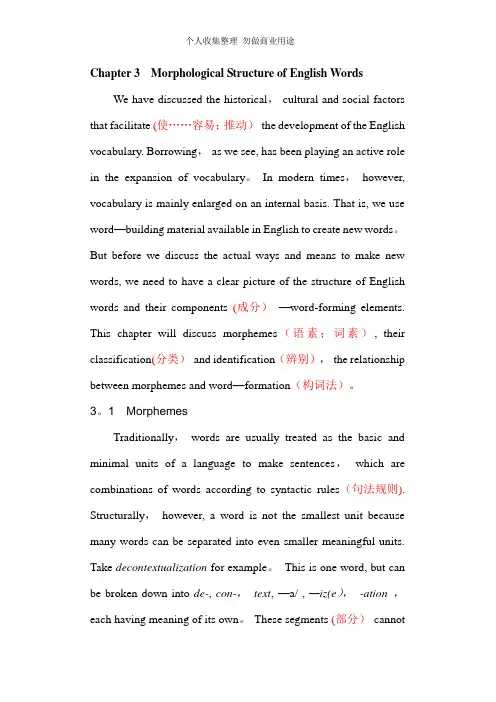
Chapter 3 Morphological Structure of English Words We have discussed the historical, cultural and social factors that facilitate (使……容易;推动)the development of the English vocabulary. Borrowing, as we see, has been playing an active role in the expansion of vocabulary。
In modern times,however, vocabulary is mainly enlarged on an internal basis. That is, we use word—building material available in English to create new words。
But before we discuss the actual ways and means to make new words, we need to have a clear picture of the structure of English words and their components (成分)—word-forming elements. This chapter will discuss morphemes(语素;词素), their classification(分类)and identification(辨别), the relationship between morphemes and word—formation(构词法)。
3。
1 MorphemesTraditionally,words are usually treated as the basic and minimal units of a language to make sentences,which are combinations of words according to syntactic rules(句法规则). Structurally,however, a word is not the smallest unit because many words can be separated into even smaller meaningful units. Take decontextualization for example。

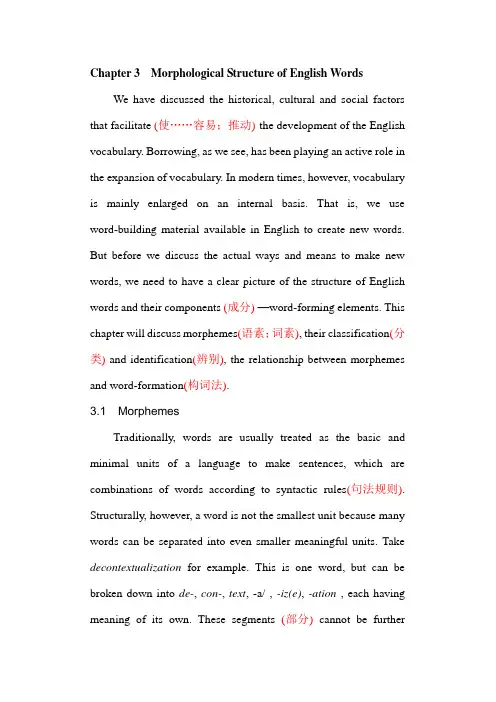
Chapter 3 Morphological Structure of English Words We have discussed the historical, cultural and social factors that facilitate (使……容易;推动) the development of the English vocabulary. Borrowing, as we see, has been playing an active role in the expansion of vocabulary. In modern times, however, vocabulary is mainly enlarged on an internal basis. That is, we use word-building material available in English to create new words. But before we discuss the actual ways and means to make new words, we need to have a clear picture of the structure of English words and their components (成分) —word-forming elements. This chapter will discuss morphemes(语素;词素), their classification(分类) and identification(辨别), the relationship between morphemes and word-formation(构词法).3.1 MorphemesTraditionally, words are usually treated as the basic and minimal units of a language to make sentences, which are combinations of words according to syntactic rules(句法规则). Structurally, however, a word is not the smallest unit because many words can be separated into even smaller meaningful units. Take decontextualization for example. This is one word, but can be broken down into de-, con-, text, -a/ , -iz(e), -ation , each having meaning of its own. These segments (部分) cannot be furtherdivided; otherwise, none of them would make any sense. Though -ation has a number of variants (变体) such as -tion, -sion, -ion, they belong to the same suffix as they have the same meaning and grammatical function and occur owing to (因为;根据) different sound environment. These minimal meaningful units are known as morphemes (morphe is the Greek word for 'form'; -eme as in 'phoneme' (音素) means 'class of' ). In view of word-formation, the morpheme is seen as 'the smallest functioning unit in the composition of words' (Crystal 1985). Syntactically(从句法上看), however, a morpheme is the minimal form of grammatical analysis (语法分析). For instance, each of the word-forms studies, studying, studied, consists of the morpheme study + ; the forms -es in studies, -ing in studying, -ed in studied are morphemes, which express grammatical concepts (语法概念) instead of deriving new words (See Classifying Morphemes).3.2 Morphs and Allomorphs(词素变体)Morphemes are abstract units, which are realized in speech by discrete units (具体单位) known as morphs(形素). 'They are actual spoken, minimal carriers of meaning' (Bolinger and Sears 1981:43). In other words the phonetic or orthographic strings(语音串或拼写字串)or segments (切分成分;节) which realize morphemes are termed 'morphs' (Bauer 1983:15). The morpheme isto the morph what a phoneme (音位) is to a phone (音素). Most morphemes are realized by single morphs like bird, tree, green , sad, want, desire, etc. . These morphemes coincide (巧合) with words as they can stand by themselves and function freely in a sentence. Words of this kind are called mono-morphemic words. Some morphemes, however, are realized by more than one morph according to their position in a word. For instance, the morpheme of plurality {-s} has a set of morphs in different sound context, e. g. in cats /s/, in bags /z/, in matches /iz/. The alternates (作为替换的事物) /s/, /z/ and /iz/ are three different morphs. The same is true of the link verb morpheme {be}. Its past tense is realized by two distinct orthographic forms was , were, each of which happens to be a word-form, realizing {preterit} and {singular}, and {preterit} and {plural} respectively and each has its own phonetic form /woz/ or /wə:/. Therefore, both was, were and their phonetic forms /woz/ and /wə: / are morphs (See discussion in Bauer, p15).An allomorph refers to a member of a set of morphs, which represent one morpheme. Just as we class phones(音素) together as allophones (音位变体) of a single phoneme(音位), so we class morphs together as allomorphs of a single morpheme. Take the plural morpheme {-s} again. Phonetically, it is realized by /s/, /z/, /iz/, all of which are allomorphs. In English, many morphemes canhave more than one allomorph, particularly those freestanding morphemes which are functional words in their own right. Once they occur in connected speech, they may be realized by different forms, depending on whether they are accented or weakened (Look at the data in the table).Morphem e AllomorphStrong Weak{am} /aem/ /əm/, /m/{ was} /woz/ /WəZ/{have } /haev/ /həv/, /v/{would } /wud/ /wəd/, /əd/,/d/{he} /hi:/ /i:/, /i/{his} /hiz/ /iz/{for} /fo:/ /fə/{to} /tu:/ /tu/, /tə/Then what is the difference between morphs and allomorphs? The relationship can be illustrated by the diagram below.Morpheme{would}morph morph morph morph →allomorph/wud/ /wəd/ /əd/ /d/3.3 Classifying MorphemesMorphemes vary in function. Accordingly, we can classify morphemes into several general categories: free versus bound, derivational versus inflectional, and lexical versus grammatical. However, their boundaries are not as clear-cut as they appear to be due to some overlapping(重叠). For the sake of discussion, we shall define each type in terms of its characteristics.1. Free versus Bound Morphemes(自由词素与粘着词素)This is the easiest and most preferred classification in morphological studies, discussed in Hatch and Brown (1995), Crystal (1985), Fromkin and Rodman (1983), Bauer (1983), Bolinger and Sears (1981) and Matthews (2000). Morphemes which are independent of other morphemes are free. These morphemes have complete meanings in themselves and can be used as free grammatical units in sentences. They are identical with(与……完全相同) words, for example, man, earth, wind, car and anger.Morphemes which cannot occur as separate words are bound. They are so named because they are bound to other morphemes to form words or to perform a particulargrammatical function.Bound morphemes are chiefly found in derived words (派生词). Let us take recollection, idealistic and ex-prisoner for example. Each of the three words comprises three morphemes: recollection (re- collect-ion) , idealistic (ideal-ist-ic) , ex-prisoner (ex- prison -er). Of the nine morphemes, collect, ideal and prison can stand by themselves and thus are free morphemes. All the rest re-, -ion , -ist, -ic, ex-and -er are bound as none of them are freestanding units.Free morphemes are all roots, which are capable of being used as words or as word-building elements to form new words like collect, ideal, prison , whereas bound morphemes consist of either roots or affixes, most of which can be used to create new words like -dict- , -ced- (接近;去), re-, -ion, -ist, -ic and ex-(前). But there are a few affixes which can only indicate such grammatical concepts as tense, aspect, number and case, for example, the -ing in watching, -er in easier, -s in books, and -ed in worked.The English language possesses a multitude of (大量的) words made up of merely bound morphemes, e. g. antecedent, which can be broken down into ante-, -ced- and -ent. Among them, -ced- is a root meaning 'approach, go to', ante-, a prefix meaning 'before' and -ent, a noun suffix meaning 'a person, a thing', thus the whole word antecedent meaning 'something that goes before'(前例;前事;先行词;祖先). These examples show clearly that bound morphemes include two types: bound root (See Root, Stem, Base) and affix.2. Derivational versus Inflectional MorphemesMorphemes which are used to derive new words are known as derivational morphemes (派生词素) because when these morphemes are conjoined, new words are derived.In English, derivatives and compounds are all formed by such morphemes. For example, a + mor + ai, clear + ance, Life + Like and homo + gen + eous are results of such morphological processes.Inflectional morphemes(屈折词素), in contrast, indicate the syntactic relationships between words and function as grammatical markers. Inflectional morphemes are confined to suffixes. There is the regular plural suffix -s (-es) which is added to nouns such as machines, fridges, desks, radios and potatoes; the same forms can be added to verbs to indicate the simple present for the third person singular such as likes, works and goes; the form -'s is used to denote the possessive case of nouns such as the children ' s library, the man ' s role and the mother-in-law' s complaints; the suffixes -er, -est are usually attached to simple adjectives or adverbs to show their comparative or superlative degrees like happier—happiest,harder—hardest. Apart from these, there is the past tense marker -ed and progressive marker -ing added to verbs. The differences between inflectional and derivational morphemes can be summarized as follows (See Hatch and Brown, p266): Inflectional Derivational(1) Does not change meaning or part of speech of the stem (1) Changes meaning or part of speech of the stem.(2) Indicates syntactic or semantic relations between different words in a sentence.(2) Indicates semantic relations within the word.(3) Occurs with all members of some large class of morphemes.(3) Occurs with only some members of a class of morphemes.(4) Occurs at margins of words.(4) Occurs before any inflectional suffixes added.3. Content versus Grammatical MorphemesOn a semantic and syntactic basis, morphemes can fall into content and grammatical morphemes (Traugott and Pratt 1980:90; Bolinger and Sears, pp66~70; Hatch and Brown, p267). Content morphemes are lexical morphemes which are used as wesee above to derive new words, so also known as derivational morphemes. These morphemes, whether free or bound, have a lexical content, hence the name. Grammatical morphemes, on the other hand, function primarily as grammatical markers. They encompass both inflectional affixes and free morphemes such as in, and, do, have, they, -while, -where, but and that, which are traditionally called functional words.3.4 Identifying Morphemes(词素的区分)Since morphemes are the minimal distinct units, they should be identifiable by their forms, meaning and distribution. Generally speaking, lexical morphemes are easy to define:Mono-morphemic: land, skyDouble-morphemic: chill + y, mis + takeTriple-morphemic: anti + govern + ment, sports + man + shipFour-morphemic:un + friend + li + ness, morph + olog( i) + cal + lyOver-four-morphemic: inter + nation + al + iz(e) + ationIf the morphemes are always consistent in form and meaning, there should be no difficulty in identification(区分). However, thereis often mismatch(不一致)between form and meaning. Some morphemes are identical(相同的) in form but different in meaning, for instance, -er in teacher, clearer and eraser. -er in teacher means 'one who', but -er in clearer indicates 'the comparative degree', and -er in eraser denotes 'an object'. Therefore, -er in each case is a different morpheme.Some morphemes are not meaningful in isolation(单独)but acquire meaning by virtue of(通过)their connection in words (Fromkin and Rodman, p116). The classic examples are cranberry(越橘), huckleberry (黑果;乌饭树浆果)and boysenberry(博弈增莓), each seeming to be a kind of berry. But when cran-, huckle- and boysen- are isolated, they are meaningless and they are incapable of forming new words with other morphemes rather than with berry. There are other morphemes which occur in many words, but their meaning is difficult to define, for instance, -ceive in conceive (想象;设想), perceive(感觉,察觉;认为)and receive. Some forms are meaningful, but not morphemes, such as fl- meaning 'moving light' in flash , flame and flicker(闪烁,忽隐忽现), and gl-meaning 'static light' in glow(发光,燃烧),glisten (闪耀;反光)and glitter(闪光;光彩夺目). These are only sound symbols often employed by poets in their literary creation but do not qualify as morphemes.The identification of inflectional morphemes is more problematic. In most cases, an inflectional morpheme can be segmented (切分)from the stem of a word and naturally can be added to the stem like the plural morpheme {s} in gloves, tables and classes. But what is the plural morpheme in men, sheep and feet ? The same is true of the past tense morpheme {ed} , which is explicit and segmentable in walked, loaded and danced. How can we isolate the past tense morpheme from knew, taught and cut ? To solve the problem, we have to resort to other ways.3.5 Morpheme and Word-formationWe know that words can be analyzed into morphemes, which are the minimal meaningful units in the composition of words. In word-formation, however, morphemes are conventionally labeled root, stem, base and affix.1. AffixAffixes are forms that are attached to words or word elements to modify meaning or function. All affixes are bound morphemes because none of them can stand as words in their own right. According to the functions of affixes, we can divide them into inflectional affixes like -s, -ed and -ing, and derivational affixeslike pre-, ex-, de-, -less, -dom and -ic. Derivational and inflectional affixes are identical with derivational and inflectional morphemes. In view of their distribution in the formation of words, affixes can fall into prefix and suffix. Prefixes are all derivational, i.e. they are used to form new words whereas suffixes embrace(包括) both derivational suffixes and inflectional suffixes. Accordingly, the above-mentioned affixes can be further grouped into prefixes: pre-, ex- and de-y and suffixes: -less, -dom, -zc, -5, -ed and -ing.2. Root, Stem, BaseBefore we begin our actual discussion of word-building processes, there are some basic concepts that need clarifying(澄清). The processes of derivation and compounding involve different word-forming elements: affixes and root or stem or base. Indeed, some people use root or stem undiscriminatingly (不加区别地) on all occasions. But these three terms are not the same, and they denote to a greater or lesser degree different concepts despite the semantic overlapping between them.A root is the basic form of a word which cannot be further analyzed without total loss of identity (Crystal 1985). As mentioned earlier, the root, whether free or bound, generally carries the maincomponent of meaning in a word. In the word internationalists, removing inter- , -at, -ist, -s leaves the root nation. If we further divide nation as * na/tion or * at /ion, though -tion and -ion coincide with the noun suffix, the other part is meaningless and the original lexical identity is totally lost. Therefore, nation defies(使不能;使落空)further analysis. In terms of derivational and inflectional morphology, a 'root is that part of a word form that remains when all inflectional and derivational affixes have been removed' (Bauer 1983). Take internationalists again. After the removal of the inflectional affix -s and the derivational affixes -ist, -al and inter-, nation is what is left and thus is the root.A stem may consist of a single root morpheme as in iron or of two root morphemes as in a compound like handcuff. It can be a root morpheme plus one or more affixational morphemes as in mouthful, understatement. To make things more clearly, we say that the stem is used only when we deal with inflectional affixes. As Bauer defines, a stem is 'that part of the word-form which remains when all inflectional affixes have been removed' (ibid). In other words, any form to which an inflectional affix is attached is a stem. Consider the word internationalists again. Nation is a root as well as a stem as the plural -s can be added to it; national is not a root as it can be further divided, but a stem because an inflectionalaffix -s can be added to it when used as a noun; similarly, international is not a root but a stem for the same reason. This is also true of internationalist, which is a stem.A base is used in this book as an all-purpose term, referring to a form to which affixes of any kind (both derivational and inflectional) can be added. It can be a root or a stem. In the case of internationalists, nation is a base, national is a base, so are international and internationalist.nation(root, stem, base)national(stem, base)international(stem, base)internationalist (stem, base)InternationalistsIt should be noted that such an example gives the impression that a stem is just as good as a base. This is not true. In many cases, a form of word can neither be a root nor a stem, but only a base. This often happens when we deal with derivational affixes exclusively, for example impracticality(不切实际;无用;不现实). Removing the derivational affix -ity leaves only the base form impractical, and by further removing im- we have the base form practical left and by still further analysis, only practice remains.impracticalityimpractical (base)practical(base)practice(root, stem, base)Therefore, in the chapters to follow, we shall employ only the term base to refer to any basic word-building element.英语词汇学第三单元课后练习及答案Questions and Tasks1. Write the terms in the blanks according to the definitions.a. a minimal meaningful unit of a language ( )b. one of the variants that realize a morpheme ( )c. a morpheme that occurs with at least one other morpheme ( )d. a morpheme that can stand alone ( )e. a morpheme attached to a base, stem or root ( )f. an affix that indicates grammatical relationships ( )g. an affix that forms new words with a base, stem or root ( )h.what remains of a word after the removal of all affixes ( )i. that part of a word that can take inflectional affixes ( ) j. a form to which affixes of any kind can be added ( )2. What is the difference between grammatical and lexicalmorphemes, and inflectional and derivational morphemes?Give examples to illustrate their relationships.3. Analyze the words in terms of root, stem and base.individualistic undesirablesanize the following terms in a tree diagram to show their logical relationships.affix morphemederivational affix free rootbound root inflectional affixprefix free morphemebound morpheme suffix参考答案1. a. morphemeb. allomorphc. bound morphemed. free morphemee. affixf. inflectional affixg. derivational affixh. rooti. stemj. base2. Inflectional morphemes are the suffixes added to the end ofwords to denote grammatical concepts such as -s (-es) , -ed,-ing and -est (to show superlative degree of adjectives andadverbs) whereas derivational morphemes are prefixes andsuffixes added to words to form new words such as pre-, dis-, un- , -lion, -er, -ness and so on.Grammatical morphemes are those used to show grammatical concepts, including inflectional suffixes as mentioned above and functional words (prepositions, pronouns, articles,auxiliary verbs), for example, but, the, do and was; lexicalmorphemes are derivational affixes including both prefixesand suffixes.3.individualisticindividualist+ic[stem, base]individual+ist[stem, base]individu+al[stem, base]in+dividu[root, stem, base]undesirablesun+desirable[stem, base]desir+able[root, stem, base]4. morpheme free morpheme=free rootbound morpheme bound rootaffix inflectional affixderivational affix prefixsuffix。
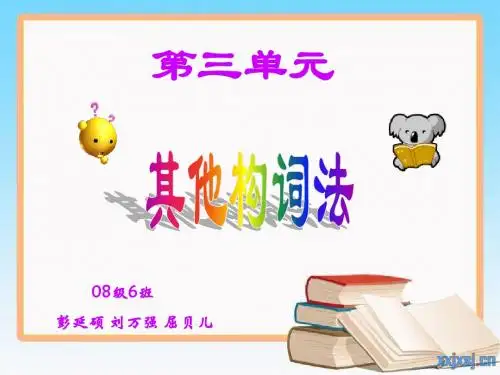
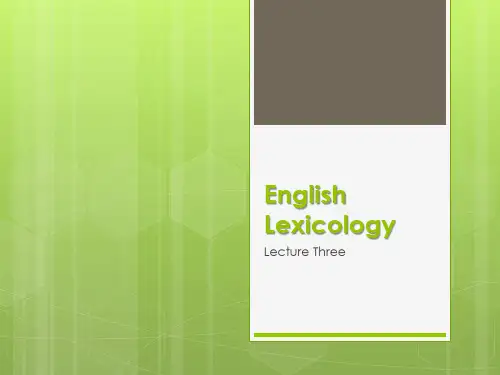
词汇学第三章第三章词语结构1我们已经讨论了历史文化社会因素对英语词汇发展的促进作用。
尽管借词正如所说,在词汇的扩张中扮演了重要的角色,但是在现代,词汇还是依靠内部基础进行扩充。
也就是说,我们使用英语中存在的材料,不管是本土的还是国外的,去创造一些新词。
在我们开始涉及词语构成的方法之前,我们需要分析词语的语形结构获得用来构成新词的不同构词元素的积极认识。
Facilitate减轻Internal内部的Morphological语形学Morphemes词素Denaturalization非自然性Variant变体Suffix后缀Owe to 由于3.1词素通常来说一个词是能独自表达意义的最小语言单位。
然而从结构上说,一个词并非最小单位因为许多词可以被划分成更小的意义单位。
以denaturalization为例,这是一个词,却能分为de- nature –al –ize –ation,每部分有它自己的含义。
这些碎片不能够进一步划分,否则,他们将不能表示任何意义。
尽管-ation有一些变体,象是-tion –sion –ion,但是当它们有同样的意义和语法功能时它们属于同一个后缀。
这些不同的形式出现是因为存在不同的发声环境。
这些最小的意义单位叫做“词素”。
换句话说,词素是“词语中最小的功能单位”。
3.2语素变体语素是抽象的单位,在话语中被认知通过分开的单位,这单位叫做“形素”。
它们实际上是能发音的最小的意义载体。
语素是一个音素发音的形素。
大多数语素通过单个的形素实现,象是“鸟“”树“”绿色“”悲伤“”想要“”需要“等等。
这些语素与词相同,由于它们能代表含义而且能够在句子中自由起作用。
这种词叫做单一语素词。
然而,一些语素被按照形素在其中排列而认识,那些替换的形素被称为”语素变体”。
例如复数语素(S)在不同的语言环境存在一些变体,象是在cats中,在“包”中,在“比赛”中。
语素变体不是随机发生的,是语音条件下可以预测的。
第三章词语结构1我们已经讨论了历史文化社会因素对英语词汇发展的促进作用。
尽管借词正如所说,在词汇的扩张中扮演了重要的角色,但是在现代,词汇还是依靠内部基础进行扩充。
也就是说,我们使用英语中存在的材料,不管是本土的还是国外的,去创造一些新词。
在我们开始涉及词语构成的方法之前,我们需要分析词语的语形结构获得用来构成新词的不同构词元素的积极认识。
Facilitate减轻Internal内部的Morphological语形学Morphemes词素Denaturalization非自然性Variant变体Suffix后缀Owe to 由于3.1词素通常来说一个词是能独自表达意义的最小语言单位。
然而从结构上说,一个词并非最小单位因为许多词可以被划分成更小的意义单位。
以denaturalization为例,这是一个词,却能分为de- nature –al –ize –ation,每部分有它自己的含义。
这些碎片不能够进一步划分,否则,他们将不能表示任何意义。
尽管-ation有一些变体,象是-tion –sion –ion,但是当它们有同样的意义和语法功能时它们属于同一个后缀。
这些不同的形式出现是因为存在不同的发声环境。
这些最小的意义单位叫做“词素”。
换句话说,词素是“词语中最小的功能单位”。
3.2语素变体语素是抽象的单位,在话语中被认知通过分开的单位,这单位叫做“形素”。
它们实际上是能发音的最小的意义载体。
语素是一个音素发音的形素。
大多数语素通过单个的形素实现,象是“鸟“”树“”绿色“”悲伤“”想要“”需要“等等。
这些语素与词相同,由于它们能代表含义而且能够在句子中自由起作用。
这种词叫做单一语素词。
然而,一些语素被按照形素在其中排列而认识,那些替换的形素被称为”语素变体”。
例如复数语素(S)在不同的语言环境存在一些变体,象是在cats中,在“包”中,在“比赛”中。
语素变体不是随机发生的,是语音条件下可以预测的。
复数词素(-s)被认识是通过在读音tpk后面,如同在“包“”骗子“”形状“,被认为是z是在dbgl之后,如同在”床“”壶“”爱好“,被认为是iz是在szfztfdz之后,如同在”班级“”盘子“”车库“”破坏“中等等。
某种情况是复数词素的变体不常见。
他可以通过内部元音的变化来认知,例如在”足“”人“”鹅“中或者通过零形素变化来表示,如在”鹿“”鱼“中。
Shape Allomorph词素变体Abstract抽象的Discrete分离的Morph形素Phoneme因素Coincide with与一致Monomorphemic单语素结构Random随机的Phonetically语音上Predictable可预见Fad爱好Garage车库Zero morph零形素过去式的标志ed也一样,通常被读t在动词结尾发音pk之后,如同在“工作“”帮忙“”在元音和象是mnl之后读d如同在“努力”“温暖”“生活”“能够”之后,读id在td之后如同在“想要”“登陆”中等等。
这同样适合于附加语素,前缀in有发音变体象是im ir il,全看前缀添加所在的首音。
如果首音是pbm,读音是im象是在“不合适”“坚定”“失调”中,但是读ir,在首音是r的时候象是在“不相容”中,读il在首音读l时,例如在“模糊”中。
诸如此类。
Applicable适当的Affixational附加的Stem词干Realization实现Improper不合适Immovable坚定Imbalance失调Irreconcilable不相容Illegible难辨认3.3语素的类型有划分语素的不同方法。
最普遍的是把它们分为自由语素和粘连语素。
3.3.1自由语素不依靠其他语素的语素是自由语素。
这些语素自己有完整的意义可以在句子中当作自由的语法单位来使用。
它们和根词是一样的,由于它们每个都是由一个单独的词根组成,例如“男人”“地球”“风”“汽车”“生气”。
因此,我们同样可以说自由语素是自由词根。
Identical同样的3.3.2粘连语素不能作为独立词出现的语素是粘连语素。
这样称呼因为它们粘连其他语素去构成单词。
粘连语素主要出现在派生词中。
让我们以“回忆“”理想的“”重犯人“为例。
每个词都是包括三个语素,这里总共有九个语素,其中只有collect ideal prison能独立存在。
这些是自由语素,其他的re- -ion –ist –ic ex- -er都是粘连语素因为其中没有一个是独立的单位。
英语拥有大量仅由粘连语素构成的词,例如“先例”,可以被分成ante- -ced- -ent.在它们中间,-ced-是意味着“接近”的词根,前缀意思是“在前面”,-ent名词后缀意味着“人,东西”,因此整个词意味着“出现在前面的东西”,这些例子清楚的展示出粘连语素包括两种,粘连词根和词缀。
Recollection回忆Idealistic理想的ExprisonerFreestand独立Multitude大量Antecedent先例Bound root粘连词根Affix词缀1.粘连词根正如例子“先例”所展示的,一个粘连词根是词中承担基础意义的部分,如同自由根词。
和自由根词不同的是,他是一个粘连形式不得不与其他词素组合来构成单词。
用dict作例子。
它是传达“说话”意思的拉丁词根,但是它自己并不是词。
然而加上词缀,它能构成大量的词。
例如,加上前缀contra(相对)和pre (在前面)我们可以得到动词“抵触”,意思是“说话反对”和“预言”意思是“事先说”。
加上后缀-or,我们得到“反驳者”和“预言家”除此,“宣言”“指示”“口授”“独裁者”“措辞”“词典”都是来源于词根dict。
在英语中,粘连词根或者是拉丁语或者是希腊语。
尽管它们数量有限,它们的生产力惊人。
它们诞生了成千上万的派生词,在现代英语中。
Fundamental基本的Contradict反驳Predict预言Beforehand预先Contradictor反驳者Predictor预言者Apart from除此Dictum宣言Dictate指示Dictation口授Dictator独裁者Diction措辞2.词缀词缀是附属在单词上或者单词元素上以修改词语意义和功能的结构。
几乎所有的词缀是粘连语素因为很少能作为独立单词使用。
根据词缀的功能,我们可以把它们分为“曲折词缀”和“派生词缀”。
(1)屈折词缀。
是附加在词尾用来表示屈折关系,因此被称为“屈折词素”。
现代英语是分析性语言。
大多数结尾都丢失了,只留给我们一些屈折词缀。
有一个通常的副词词缀-s(-es加在名词上象是“机器”“冰箱”“桌子”“无线电”“马铃薯”。
同样的结构-s(es)可以加在动词上表示第三人称单数一般现代时,象是“喜欢”“工作”“去”。
形式’s是另一种形式用来表示名词所有格象是“孩子的图书馆”“男人的角色”“女招待的声音”“岳母的抱怨”我们还有后缀er,est,它们通常加在简单形容词和副词后面去表示它们的比较级和最高级,例如“高兴”“艰难”。
除了这些,还有过去时态的标志“ed”如同上面所提及的,“ing”加在动词上构成现代分词或者动名词。
屈折词缀的数量很少而且固定。
这使得英语称为最容易学习的语言之一。
(2)派生词缀。
正如术语所说,派生词缀是加在其他语素上建立新词的词缀。
派生词缀可以分为前缀和后缀。
前缀出现在词前,后缀出现在词后。
例如,“战前”“海底”“向北”“血腥”,这些构词语素中,pre和sub是前缀,因为它们每次出现在基础词的前面而ward和y是后缀,因为它们出现在每个词的结尾。
(关于词语构成的详细讨论。
)基于我们的讨论。
我们能列出语素的类型在下面的表格里。
语素自由语素=自由词根粘连粘连词根词缀派生词缀前缀后缀屈折词缀Prefix前缀Suffix后缀Prewar战前Subsea海底complaint Fridge冰箱Role角色Superlative最高级Gerund动名词3.4词根和词干在我们开始构词过程的实际讨论之前,有一些概念需要处理澄清因为这些概念可能经常以适当的方式被涉及。
词缀法和混合涉及不同的词语构成因素,词缀和词根或词干。
实际上,一些人使用“词根”和“词干”相互替换。
在本书中,这两个术语有不同的使用。
词根是一个词的基础形式不能在没有丧失定义的前提下继续分解。
如同早先提及的,词根,不管是自由的还是粘连的,通常负担词中的主要意思。
在单词“国际主义者”中,去除inter al ist s之后留下了词根nation。
如果我们进一步划分nation 为an /tion 或者at/ion。
尽管tion和ion与名词后缀类似,其他的部分是无意义的并且最初的词语意义全部丧失。
根据派生和屈折语形学,“一个词根是词语中去除所有屈折词缀和派生词缀都去除剩下的部分。
”Morphology形态学Loss失去Due course适当的时候Clarify澄清Compounding组合一个词干可以包括一个词根语素象是“铁”或者两个词根语素组成,象是在复合词中,如“手铐”。
它也可以是一个词根语素加一个以上词缀语素象是“一嘴”“低估”。
因此,词干可以被定义为任何词缀都能够添加的形式。
再来看“国际主义者”。
在这个词中,nation既是词根也是词干。
其他的national international internationalist都是词干。
为了安全起见,造词语构成意义的讨论中,我们将只使用词干因为它可以替代词根并且也可用来指代任何比词根大的形式。
Mouthful一嘴underestimate Handcuff手铐Page45~51。